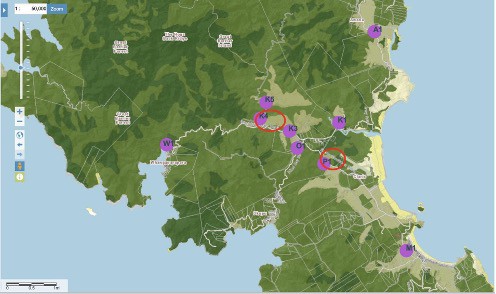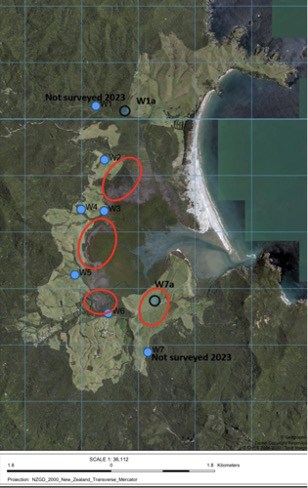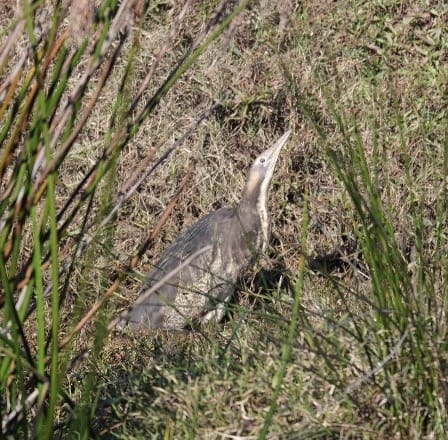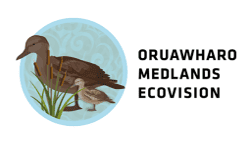On a beautiful still evening in October a team of 18 volunteers set out to listen for booming bittern in the swamps and wetlands of Aotea. 16 sites across the island, 7 in the north and 9 in the south, had people quietly sitting listening for a boom or two around dusk. It was a lovely, peaceful thing to be part of and we are really pleased with the results overall.
Some of us heard a lot of other birds at our listening site, including mātātā (fern bird) but no bittern, though exactly half of the sites heard booming bitterns, most of them in the north.

Southern survey sites

Northern survey sites
The purple/blue dots on the two maps mark the survey sites and the red ovals or circles mark the area where the bittern we heard booming would have come from.

Image on a sign on the way to hot pools of bittern on nest. Wish I had actually seen this!
The last time a combined bittern survey was conducted on Aotea was in 2012 by Amelia Geary with the help of a group of volunteers and then in spring of 2020 an acoustic survey was conducted, showing a potential slight increase in birds since 2012.
In 2023 we have detected even more birds, but we are not sure if it is due to more counters or if the bittern numbers really have increased here in the last decade. We have now set up the template for an annual survey using the same survey points, so we should be able to gather more information over the next few years.
John Ogden has deciphered our data from this year and deduced that, assuming only males were booming and an equal number of females were present, we currently have a minimum of 14 and a possible maximum of 20 bittern on Aotea at the moment. He says that even the minimum figure is more than twice earlier estimates.
The australasian bittern or matuku-hūrepo is a nationally critical, native bird of New Zealand and their population size is estimated to sit around only 900 in NZ with a further 900 in Australia and around 50 in New Caledonia. These birds are very elusive under normal circumstances, but in spring the males make their beautiful voices heard, booming – as their sound is called – across the wetlands that are their homes. This sound is a mating call, which can go unanswered for months each year, as some locals will be only too aware of. You can hear this sound from August to early December if a male bittern is looking for female company near you.
The bittern in the photo below had popped in for a quiet snack from the frog and elver buffet across from St. John’s Church, but was sprung and caught on camera. These large birds blend in so well with their raupo and baumea surroundings, but it is still a bit hard to hide when you weigh between 900 and 1400 grams and have a super long neck. They do this really odd stick impression-thing in an attempt to go unseen, stretching their long neck straight up in the air, but once they have been spotted this just makes them stand out even more. If only they could see themselves, right?

Bitter in Medlands, Lotte McIntyre
The booms can be a unique signature and can distinguish different birds from each other depending on the amount of booms in each sequence, though mostly it is around three per call. Us bird nerds are quite grateful for this very unique sound as it makes it a lot easier to guesstimate the relative population size of these large birds of the heron family. The sound is best likened to a didgeridoo with its deep, hollow sound.
If you have never heard a bittern boom visit: www.nzbirdsonline.org.nz/species/australasian-bittern

Always prepared, Kirsty Prior’s “travel kit”
There has been a lot of talk about matuku hūrepo or australasian bittern of late and efforts are being made across Aotearoa to gather and connect some meaningful data to better protect and monitor these birds. Spurred on by such initiatives OME and DOC put together this community exercise with a mix of enthusiasm and expertise that resulted in a great experience. Nationally the Love Bittern website and Trust have been formed and a data sharing platform has been created. If you see or hear bittern OME would love to know about it. John Ogden has kept records of incidental sightings across Aotea since 2002 and OME are helping to carry this on. You can also record your bittern on the Love Bittern website or on the eBird Atlas. They would love to hear all about it.
If you would like to go on our list of possible listeners for October 2024, please get in touch: medlandsecovision@gmail.com
To read the full report on our findings, John Ogden’s report can be found on OME’s webpage.
Thanks for reading
The OME team
Words by Lotte McIntyre on behalf of Oruawharo Medlands Ecovision



